
The De Tonti Square Historic District is a historic district in the city of Mobile, Alabama, United States. It was placed on the National Register of Historic Places on February 7, 1972. It is a nine-block area, roughly bounded by Adams, St. Anthony, Claiborne, and Conception Streets. The district covers 28 acres (0.11 km2) and contains 66 contributing buildings. It was named in honor of Henri de Tonti and consists mainly of townhouses built between 1840 and 1860. It includes numerous examples of the Federal, Greek Revival, and Italianate architectural styles.
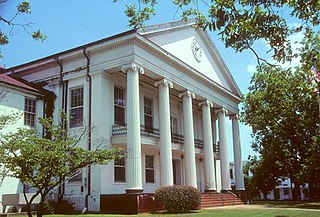
The Marion Courthouse Square Historic District is a historic district in Marion, Alabama. It is centered on the Perry County Courthouse and includes examples of Greek Revival, Gothic Revival, and Tudor Revival architecture. The boundaries are roughly along Green, Washington, Jefferson, Jackson, Franklin, Clements, Centreville and Monroe Streets. It was added to the National Register of Historic Places on February 16, 1996.

There are nine historic districts in Meridian, Mississippi. Each of these districts is listed on the National Register of Historic Places. One district, Meridian Downtown Historic District, is a combination of two older districts, Meridian Urban Center Historic District and Union Station Historic District. Many architectural styles are present in the districts, most from the late 19th century and early 20th century, including Queen Anne, Colonial Revival, Italianate, Art Deco, Late Victorian, and Bungalow.

There are 69 properties listed on the National Register of Historic Places in Albany, New York, United States. Six are additionally designated as National Historic Landmarks (NHLs), the most of any city in the state after New York City. Another 14 are historic districts, for which 20 of the listings are also contributing properties. Two properties, both buildings, that had been listed in the past but have since been demolished have been delisted; one building that is also no longer extant remains listed.

The Court Square–Dexter Avenue Historic District is a 17.6-acre (7.1 ha) historic district in downtown Montgomery, Alabama, United States. Centered on the Court Square Fountain, the district includes twenty-seven contributing buildings and two objects. It is roughly bounded by Dexter Avenue, Perry, Court and Monroe streets. Architectural styles in the district include Italianate, Late Victorian, and various Revival styles. It was placed on the National Register of Historic Places on March 1, 1982. The boundaries were subsequently increased on August 30, 1984.

The Dowe Historic District is a 1-acre (0.40 ha) historic district in Montgomery, Alabama. It includes 320 and 334 Washington Avenue and 114–116 South Hull Street. The architectural style of the four contributing buildings ranges from Greek Revival to Queen Anne. The district was placed on the National Register of Historic Places on December 29, 1988.

The Garden District is a 315-acre (127 ha) historic district in Montgomery, Alabama.
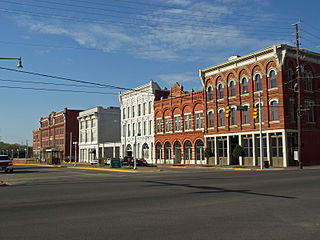
The Lower Commerce Street Historic District is a 45-acre (18 ha) historic district in the old commercial district of Montgomery, Alabama. It includes fifty-two contributing buildings. It is roughly bounded by the Central of Georgia railroad tracks, North Lawrence Street, Madison Avenue, and Commerce Street. Architectural styles in the district include the Italianate, Classical Revival, and Renaissance Revival. It was placed on the National Register of Historic Places on March 29, 1979, the boundaries were subsequently increased on February 25, 1982 and January 15, 1987.

The E.P. Adler House is a historic building located in the central part of Davenport, Iowa, United States. It has been individually listed on the National Register of Historic Places since 1983. In 1984 it was included as a contributing property in the Vander Veer Park Historic District. It has been on the Davenport Register of Historic Properties since 2008.

Hillside, also known as the Charles Schuler House, is a mansion overlooking the Mississippi River on the east side of Davenport, Iowa, United States. It has been individually listed on the National Register of Historic Places since 1982, and on the Davenport Register of Historic Properties since 1992. In 1984 it was included as a contributing property in the Prospect Park Historic District.

The Avondale Park Historic District in Birmingham, Alabama is a 200 acres (81 ha) historic district that was listed on the National Register of Historic Places in 1998. It includes work dating to 1886 and work by Burnhum & Greer. It includes Queen Anne, Colonial Revival, and Tudor Revival architecture. The listing included 425 contributing buildings, one contributing site, and two contributing structures.
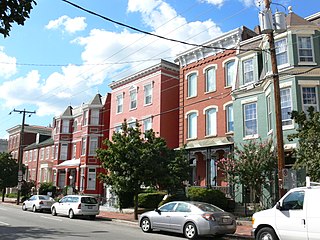
The Block 0-100 East Franklin Street Historic District is a national historic district located at Richmond, Virginia. It is located west of downtown. The district encompasses 21 contributing buildings built between about 1840 and 1920. The district is characterized by numerous mid- to late-19th century brick town houses in a variety of popular 19th-century architectural styles including Queen Anne, Italianate, and Greek Revival.

The Brookland Park Historic District is a national historic district located at Richmond, Virginia. The district encompasses 1,157 contributing buildings located north of downtown Richmond and Barton Heights. The primarily residential area developed starting in the late-19th century as one of the city's early “streetcar suburbs.” The buildings are in a variety of popular late-19th and early-20th century architectural styles including frame bungalows and American Foursquare. The neighborhood is characterized by frame dwellings with a single-story porch spanning the facade, and either Colonial Revival or Craftsman in style, moderate in scale, with understated materials and stylistic expression. Notable non-residential buildings include the North Side Branch building, Brookland Inn, former A&P Grocery Store, North Side Junior High School, Barack Obama Elementary School, St. Paul's School building (1923), St. Philip's Episcopal Church, First African Baptist Church (1922), and Garland Avenue Baptist Church.
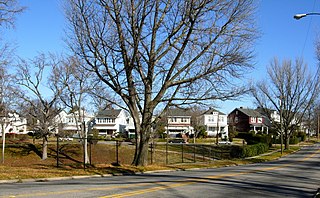
The Battery Court Historic District is a national historic district located at Richmond, Virginia. The district encompasses 549 contributing buildings and 1 contributing site located north of downtown Richmond and west of Barton Heights and Brookland Park. The primarily residential area developed starting in the early-20th century as one of the city's early “streetcar suburbs.” The buildings are in a variety of popular late-19th and early-20th century architectural styles including frame bungalows, American Foursquare, Colonial Revival, Tudor Revival, and Mission Revival. Notable non-residential buildings include the Overbrook Presbyterian Church and Battery Park Christian Church.

Marion Street Area Historic District is a national historic district located at Rock Hill, South Carolina. It encompasses 28 contributing buildings and 1 contributing site in a middle-class residential section of Rock Hill. The bulk of the district developed between 1906 and 1925. Architectural styles represented include Victorian, Classical Revival, Colonial Revival, and Bungalow. Notable buildings include the Rawlinson House, McCall-Jones-Byrant House, Davis House, and W. B. Jenkins House.

Fisher Park Historic District is a national historic district in the Fisher Park neighborhood, Greensboro, Guilford County, North Carolina. The district encompasses 541 contributing buildings, 2 contributing sites, and 44 contributing structures in a predominantly residential section of Greensboro. The houses were largely built between the 1900s and 1930s and include notable examples of Queen Anne, Colonial Revival, Gothic Revival, American Foursquare, and Bungalow / American Craftsman-style architecture. Located in the district are the separately listed Dixon-Leftwich-Murphy House, John Marion Galloway House, Julian Price House, and Latham-Baker House. Other notable buildings include the First Presbyterian Church (1928), Holy Trinity Episcopal Church (1922), Gant-McAlister House, and A.J. Schlosser House.

Chili–West Historic District is a national historic district located at Rochester, Monroe County, New York. The district encompasses 508 contributing buildings in a predominantly residential section of Rochester. The district developed between about 1874 and 1935, and includes buildings in a variety of architectural styles including Queen Anne, Colonial Revival, Gothic Revival, and Tudor Revival, Mission Revival, and Bungalow / American Craftsman. The dwellings reflect designs directed toward a middle-class and working class clientele in a newly developing area of Rochester's Nineteenth Ward. Located in the district is the former St. Augustine Roman Catholic Church complex.
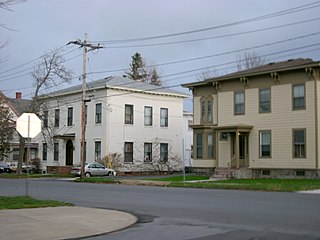
Kingsford Historic District is a national historic district located at Oswego, Oswego County, New York. It encompasses 76 contributing buildings in a predominantly residential section of Oswego. It developed between about 1830 and 1910, and includes notable examples of Italianate, Romanesque Revival, Colonial Revival, and Tudor Revival style architecture. Located in the district is the separately listed Kingsford House. Other notable buildings include the former St. Matthew's Lutheran Church (1888), 40 West Oneida Street (1898) designed by Claude Fayette Bragdon, the former Public School #3 (1860s), and West Baptist Church (1867) designed by Andrew Jackson Warner.

The Waterloo West Commercial Historic District is a nationally recognized historic district located in Waterloo, Iowa, United States. It was listed on the National Register of Historic Places in 2014. At the time of its nomination the district consisted of 25 resources, including 22 contributing buildings, and three non-contributing buildings. The buildings are from one to three stories in height, and for the most part are clad in brick. The earliest building dates to 1882 and the latest, as of 2014, to 2000. For the must part they utilize the Victorian, Romanesque Revival, and Italianate commercial styles. Ornamentation is minimal. The buildings are all commercial structures with the exception of the former Burlington, Cedar Rapids and Northern Railway Depot, designed by the Cedar Rapids architectural firm of Josselyn & Taylor. Several of the buildings housed automobile-related businesses that clustered along West Fifth Street beginning in the 1920s and 1930s.























